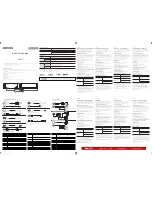
MDX [en-US]
24
Motor rating
Maximum Motor Switchings / Hour
< 12 kW (< 16 hp)
100
12 kW – 100 kW (16 hp – 135 hp)
150
> 100 kW (> 135 hp)
200
6.4.3
Density of the Medium Handled
The power input of the pump will increase in proportion to the density of the medium handled. To avoid overloading of the motor,
pump and coupling, the density of the medium must comply with the data specified on the purchase order.
6.5
Underwater Pump Operation
The Underwater Cartridge Bearing Assembly (UCBA) uses Duo-Cone seals in the end cover. Sealing is accomplished with two
hardened, precision ground faces running against each other. An elastomer toric applies pressure to the faces and allows the
seal rings to accommodate axial and radial run out. The contact pressure and shaft speed will generate heat in the seal faces
that must be removed by the surrounding water as the pump is running. Correct installation and adjustment is extremely critical
to the proper function and life of these seals.
Due to the angular position of ladder mounted pumps in most dredge operations, the UCBA must be completely filled with oil to
provide lubrication to the rear thrust bearing when the cutter head is lowered. This requires the use of tank mounted above the
deck to detect leaks and accommodate internal pressure changes. A pressurized recirculating system can be used, but the
simplest method is an expansion tank suitable for operation within the marine environment. This must be designed to prevent
dirt, water or other contaminants from entering the oil system while providing a vent to atmosphere.
This tank keeps a positive pressure on the bearing side of the Duo-Cone seals to counteract the water pressure as the pump is
submerged. The tank should be mounted high enough to maintain a pressure of about 48 kPa (7 psi) above what is created by
the maximum water depth. Note that the specific gravity of oil is only about 85% of water and must be taken into account when
calculating the mounting height of the tank.
The tank should have an oil level indicator to allow the operator to see if the level changes. After the oil temperature stabilizes,
the level should remain constant and any significant change would indicate a leaking seal. This early warning can prevent oil
from leaking into the surrounding water and avoid bearing failure.
Dredge pumps are designed to run with the UCBA and Duo-Cone seals fully submerged. This enables the surrounding water to
dissipate heat generated by the bearings and seal faces. If the pump will be operated above the water line for extended periods,
the bearings can create extra heat in the oil and the seal faces may overheat. Provisions should be made to provide a supply of
cooling water to each Duo-Cone seal and a water spray onto the UCBA itself. If the pump will run continuously above water,
other sealing systems are recommended, or oil circulating and seal cooling systems will be required.
Care should be taken to operate the pump within the speed limitations specified by GIW on the pump drawing for the particular
seal size installed. If a seal is replaced, it must be installed with the correct gap (specified by GIW for each seal size) between
the seal holders, as this distance provides the correct seal face pressure for proper operation.
Failure to operate the seals within the above parameters may result in premature seal failure or oil leakage through the Duo-
Cone seals. Any change in the operating conditions should be discussed with your GIW / KSB representative to establish if the
new conditions are suitable for the equipment.
Summary of Contents for GIW MDX
Page 53: ...MDX en US 53 14 Notes...
















































